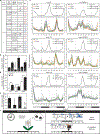Timing of plant immune responses by a central circadian regulator
- PMID: 21293378
- PMCID: PMC6601609
- DOI: 10.1038/nature09766
Timing of plant immune responses by a central circadian regulator
Abstract
The principal immune mechanism against biotrophic pathogens in plants is the resistance (R)-gene-mediated defence. It was proposed to share components with the broad-spectrum basal defence machinery. However, the underlying molecular mechanism is largely unknown. Here we report the identification of novel genes involved in R-gene-mediated resistance against downy mildew in Arabidopsis and their regulatory control by the circadian regulator, CIRCADIAN CLOCK-ASSOCIATED 1 (CCA1). Numerical clustering based on phenotypes of these gene mutants revealed that programmed cell death (PCD) is the major contributor to resistance. Mutants compromised in the R-gene-mediated PCD were also defective in basal resistance, establishing an interconnection between these two distinct defence mechanisms. Surprisingly, we found that these new defence genes are under circadian control by CCA1, allowing plants to 'anticipate' infection at dawn when the pathogen normally disperses the spores and time immune responses according to the perception of different pathogenic signals upon infection. Temporal control of the defence genes by CCA1 differentiates their involvement in basal and R-gene-mediated defence. Our study has revealed a key functional link between the circadian clock and plant immunity.
Conflict of interest statement
The authors declare no competing financial interests.
Figures



Comment in
-
Plant biology: Defence at dawn.Nature. 2011 Feb 3;470(7332):44-5. doi: 10.1038/470044a. Nature. 2011. PMID: 21293364 No abstract available.
References
-
- Jones JD & Dangl JL The plant immune system. Nature 444, 323–329(2006). - PubMed
-
- Lam E, Kato N & Lawton M Programmed cell death, mitochondria and the plant hypersensitive response. Nature 411, 848–853 (2001). - PubMed
-
- Donofrio NM & Delaney TP Abnormal callose response phenotype and hypersusceptibility to Peronospoara parasitica in defence-compromised Arabidopsis nim1–1 and salicylate hydroxylase-expressing plants. Mol. Plant Microbe Interact 14, 439–450 (2001). - PubMed
Publication types
MeSH terms
Substances
Grants and funding
LinkOut - more resources
Full Text Sources
Other Literature Sources
Molecular Biology Databases

